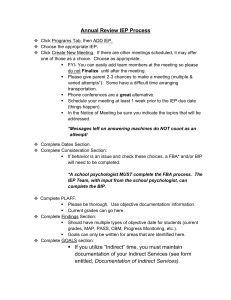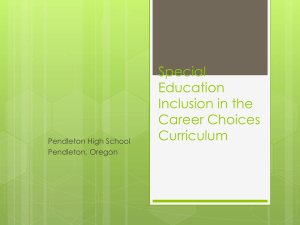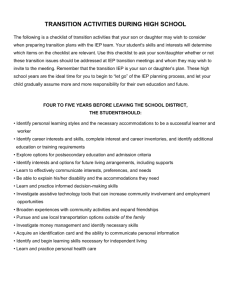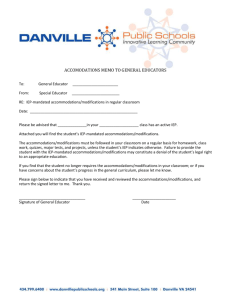Levels of Support Packet 2013-14
advertisement
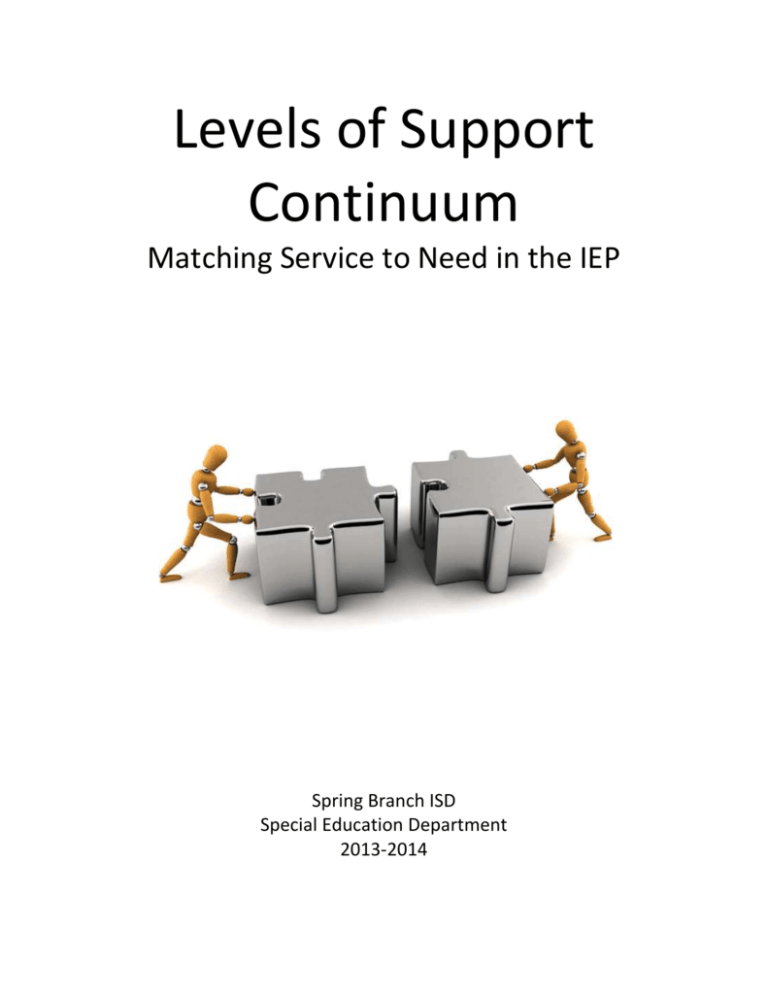
Levels of Support Continuum Matching Service to Need in the IEP Spring Branch ISD Special Education Department 2013-2014 Indirect Support Indirect services involve external support and consultation to general education teachers who work directly with students with special needs. The Special Education teacher does not work with the students, but with the teachers who provide the direct instruction and accommodations. Indirect Support Looks Like General Education teacher has primary responsibility for instruction and implementation of IEP directed accommodations Special Ed teacher consults/collaborates/plans/problem solves with general education teacher when necessary to provide resources, materials, suggestions for accommodations and/or strategies IEP Documentation Accommodations, supplementary aids and services Goals may not be necessary for the student in the subject area requiring indirect support** Requires a Service Log documenting frequency and type of support provided on behalf of the student Noted on accommodation page(s) as “Support for General Education teacher” Written discussion of supports needed for school personnel in the deliberations **If the student’s educational needs can be met with this level of service in ALL subject areas, special education eligibility needs to be reviewed. With INSTRUCTIONAL CHANGES: LOW This level of support involves the General Education teacher implementing accommodations with intermittent or limited direct support provided to the student by Special Education staff (Teacher or Paraprofessional). In addition, service delivery may include indirect support. This service delivery model is intended for students that require functional (non-TEKS) skill support to access the general education curriculum. Low Intensity Support Looks Like General Education teacher has primary responsibility for instruction and implementation of IEP directed accommodations Planning and/or on-going communication between special education teacher and general education teacher is evident One Teach/One Assist is the prevailing instructional arrangement for inclass support Direct support from special education staff addresses specific functional and/or academic access goals of the student- examples include technology training, supplemental aid instruction, study skills, behavior skills, organizational skills. IEP Documentation Accommodations and measurable goal(s) At least one goal targeting functional skill(s) needed to access the curriculum (Not TEKS based) Generally, needs can be met with 30 minutes to 2 hours per week of In Class Support. Requires a Service Log documenting frequency and type of support provided on behalf of the student Sort of Like - Medium This level of support involves the General Education teacher implementing accommodations and goal instruction with daily direct support provided to the student by Special Education staff (Teacher or Paraprofessional). In addition, service delivery may include indirect support. This service delivery model is intended for students who have academic and/or functional goals that require supplemental direct instruction to access the general education curriculum. Medium Intensity Support Looks Like: General Education teacher has primary responsibility for instruction and implementation of IEP directed accommodations General Education teacher and Special Education teacher share responsibility for providing instruction that leads to progress on goals Regular planning and/or on-going communication between special education teacher and general education teacher is evident Direct support from special education staff addresses specific functional and/or academic goals of the student- examples include reading instruction, technology training, supplemental aid instruction, study skills, behavior skills, social skills, organizational skills. Regular use of supplemental aids, study guides, skeleton notes, etc. Use of co teach approaches is evident Accommodations are observable IEP Documentation Accommodations and measurable goals Functional and/or academic goals describe specially designed instruction that is required for academic/behavioral support Students requiring this level of support typically have multiple needs identified in the PLAAFP and would have multiple goals in the subject area to address the needs Generally, needs can be met with 40% to 60% of the class time or period of In Class Support Requires a Service Log documenting frequency and type of support provided on behalf of the student Some: HIGH This level of support involves the General Education teacher and the Special Education teacher jointly planning and delivering instruction, including accommodations and modifications, with daily direct support from the Special Education Teacher, provided in the general education classroom for the majority of the class period. This service delivery model is intended for students that require extensive modification to achievement standards and/or behavioral expectations. Based on multiple measures of objective and valid data over time, the ARD Committee must be reasonably certain the student is not likely to reach grade-level proficiency within the year covered by his or her IEP. High Intensity support Looks Like: General Education and Special Education have joint responsibility for instruction Consistent regular on-going planning between general education teacher and special education teacher is evident Regular use of co teach approaches with emphasis small group arrangements Direct support from special education staff addresses specific academic goals of students that include changes to the performance standards, prioritized student expectations, altered instructional activities, assignments, materials, assessments, as well as include extensive accommodations Behavioral and/or functional needs are addressed if indicated by IEP IEP Documentation Extensive accommodations and modifications Goals identified describe how the standards are modified for academic/behavioral instruction Students requiring this level of support have extensive needs identified in the PLAAFP which result in a significant number of goals for the subject area Generally, needs require 60% to 100% of class time or period with In Class Support or Co Teach Support May require a Service Log documenting frequency and type of support provided on behalf of the student Something Different: Specialized Specialized support requires Special Education teachers to provide direct, intensive instruction, support and modifications to students outside of the general education classroom for IEP skill development. This service delivery model is intended for student needs that are high in intensity, are academic, behavioral or medical in nature and require significant modification of performance standards, content or behavioral expectations. High intensity needs are such that: Placement in a general education classroom prohibits the student from achieving the goals and/or objectives contained in the IEP even though supplementary aids and services are used. Implementing the goals and objectives in the general education classroom would eliminate essential components of the general education curriculum and/or significantly disrupt the general education teacher’s ability to provide instruction and/or maintain routines. Implementing the student’s behavior intervention plan means that other students would not benefit from academic instruction or nonacademic activities. Specialized Support Service Looks Like: Special Education teacher has primary responsibility for instruction The Special Education Teacher and the General Education Teacher routinely communicate with one another and coordinate efforts to align the work in the specialized support classroom with the work in the general education classroom Direct, intensive targeted academic instruction Resource Classroom Critical Elements Highly structured, highly supervised social skills instruction and behavior management AIM Classroom Critical Elements AB Classroom Critical Elements Developmentally appropriate program for ages 3-5 addressing significant cognitive, communication, social, motor or self help deficits PPCD Classroom Critical Elements Supervised, contained classroom which emphasizes a limited sample of substantially simplified content and development of adaptive behavior LifeskillsAPPLE Critical Elements Emphasis is on providing instruction that accelerates achievement and is designed to enable return to the general education classroom or to reduce the time spent in the separate setting Whole group instruction occurs only when the instruction delivered in this format allows for each and every student to participate IEP Documentation Measurable academic and functional goals as well as a behavior intervention plan, if appropriate Goals are required for every subject area where a student is pulled from a general education setting (may or may not include modifications) Per Least Restrictive Environment Consideration–Full class time/period to full day special education setting. Support Considerations for Access to the General Curriculum Curriculum Focus Instructional Examples Grade-level TEKS • TEKS instruction with or without classroom accommodations as determined for student success • Student is responsible for all Objectives and Student Expectations for each subject • Provide tools for study skills, behavior regulation, organization • Provide additional notes, taped lectures, taped textbooks, manipulative materials, or other assistive technology to help access information • Provide extra time to complete assignments • Format pages to help with clarity and visual organization • Reading support • Shorten the length of classroom tests • Provide opportunities for a student to demonstrate knowledge and understanding of information by using methods that emphasize the student’s strengths • Provide access to technology, manipulatives, and resources that facilitate the demonstration of knowledge and understanding of the information • Simplify directions and reduce complexity of assignments • Provide student with a smaller teacher-student ratio during instruction • Reduce the complexity of vocabulary and sentence structure • Delete extraneous information on assignments Grade-level TEKS - Modified • TEKS instruction using accommodations and modifications that allow access to the gradelevel state-mandated curriculum • Student is provided with instruction and modifications that address his/her individual learning style and needs • Student is responsible for all objectives for that subject • Complexity of Student Expectations is simplified** **Goals should identify most critical TEKS Objectives for the purpose of measuring progress over a one year period and should describe how the standards are modified Grade-level TEKS - Alternate • TEKS instruction simplified to focus on reduced number of academic skills while addressing both real-life application of skills and the student’s needs • Find areas within the TEKS for the student to access using methods that emphasize the student’s strengths • Provide the student with adult support as needed to access environments and activities • Find real-life applications of assignments to maximize generalization of skills • Provide varying levels of cueing and prompting to ease the student toward independence • Use technology and communication devices that provide student with effective methods of response Support Considerations based on Needs in PLAAFP Indirect – support for the general education staff Low –functional skill needs Medium – supplemental instructional needs High – Modifications and supplemental instructional needs Specialized - Modifications and supplemental instructional needs only when goals and /or objectives can’t be achieved in the general setting Specialized Support Specialized support programs may be determined appropriate for needs that are not academic in nature i.e. structured behavior management. For additional clarification on support considerations see Levels of Support Continuum.


